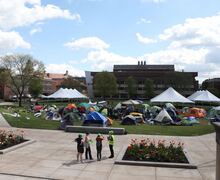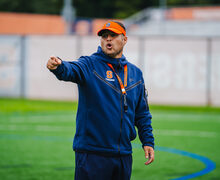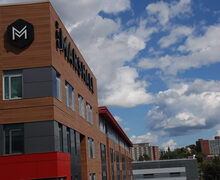SUNY Oneonta closes campus due to lack of testing, spike in COVID-19 cases
Will Fudge | Staff Photographer
The college did not require students to get testing for coronavirus prior to arriving on campus.
The Daily Orange is a nonprofit newsroom that receives no funding from Syracuse University. Consider donating today to support our mission.
As Syracuse University continues through its third week of in-person classes, SUNY Oneonta, which opened for the fall semester the same day as SU, has already seen a spike in coronavirus cases.
SUNY Oneonta announced on Sept. 3 that the college would send all students home for the remainder of the semester after the number of positive cases on campus rose to almost 400. There are at least 696 positive cases on SUNY Oneonta’s campus as of Wednesday, according to the SUNY tracking system.
The college did not require students to take a COVID-19 test before moving in, which led to the spike in cases that SU has been able to avoid so far, said Brooks Gump, a public health professor at SU’s Falk College.
“(At) SU, we have been aggressively testing things like wastewater and following that up with subsequent other testing,” Gump said. “The idea is obviously to test, most importantly, the asymptomatic people.”
Testing students as soon as they arrive on campus or after they come out of quarantine is critical, Gump said.
“If you bring someone out of the state and test them two weeks later, you’ve lost your advantage,” he said.
SUNY Oneonta announced a pool testing process on Aug. 27 after 13 students tested positive for the virus during the first three days of reopening.
Stephen Thomas, division chief of infectious diseases at Upstate Medical University, said that large gatherings were another main factor that contributed to the outbreak at SUNY Oneonta.
“There are a list of risky behaviors which we know will increase the risk of infection and transmission, and it sounds as if these students checked the box on many of them,” Thomas said.
Barbara Jean Morris, president of SUNY Oneonta, announced Aug. 29 that the college had suspended five students in connection with parties. Photos of students violating safety protocols also surfaced a few days later, Morris said in a statement on SUNY Oneonta’s COVID-19 dashboard.
SUNY Oneonta did not respond to a request for comment.
While SUNY Oneonta started its fall 2020 semester on Aug. 24, the same day that SU resumed classes for the semester, less than 3% of its courses were scheduled to take place in person.
William Ashbaugh, a history professor at SUNY Oneonta, planned his classes assuming he would have to move online during the semester, but he didn’t expect the college to shut down in early September.
While the overall New York state positivity rate remains low, coronavirus cases have spiked in areas of Western New York and Oneonta since late August.
Among the total 1,120 reported positive cases in SUNY schools, 62% were from SUNY Oneonta as of Wednesday, according to the SUNY tracking system.
“You have to remember this is a more infectious virus than influenza,” Thomas said. “Once there is a transmission cycle set in motion, it will take aggressive public health action and time to see the end of the cycle.”
Since COVID-19 has an incubation period of up to 14 days, it could take a while to reduce cases after a major transmission event, in which numerous people are infected at once, Thomas said.
“If you want kids to stay in school, restaurants to stay open, gyms accessible, and, most importantly, the number of people who suffer and die from COVID to remain low, make good decisions,” Thomas said.
Published on September 9, 2020 at 10:01 pm
Contact Francis: [email protected] | @francis_towne





